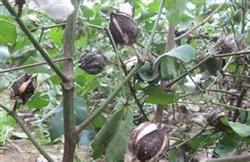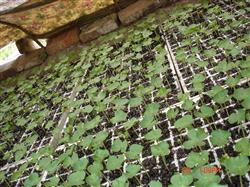How to prevent and control rotten cotton and peach

1. Dredge the ditch before and after the rain, timely clean the cotton field drainage ditch, require the ditch to be smooth, ensure that there is no stagnant water in the cotton field when it rains, the ditch can quickly discharge open water after rain, and effectively reduce the underground water level in the cotton field. two。 Pruning and leafing in the late growth stage of cotton can not only reduce nutrient consumption and save nutrients, but also reduce the degree of shade in the field, which has an obvious effect on the control of rotten peach. In the later stage, the emphasis should be placed on the cotton fields where the growth is fierce and the closure is early and heavy. it is necessary to seize the time to get rid of the old, weak, sick and yellow leaves in the lower part of the main stem, and open the "skylight" at the right time, that is, to remove the upper leaves of the main stem, cut off the leaf branches and empty fruit branches in time, beat the axillary buds as soon as possible, and take the removed branches and leaves out of the field for treatment, and if necessary, you can also remove cotton peach bracts. 3. Pushing plants for drying from late August to late September can be carried out in cotton fields with exuberant growth and heavy overlap of branches and leaves. Choose a sunny day to push open the cotton row, so that the adjacent two rows of cotton plants are tilted in the shape of "eight", so that the other side is open, and the sun is fully exposed, so as to reduce the humidity in the field and reduce the breeding and reproduction of germs. If Rain Water is more, rotate every 5-7 days, first dry narrow row, then dry wide row, so alternately push plants to dry line, can effectively reduce the humidity in the field. 4. Killing cotton borer in the middle and later stage of cotton (such as cotton bollworm, red bollworm, diamond, etc.), the wound of eating on cotton peach is often easy to cause bacterial infection and lead to rotten peach. Therefore, it is very important to control pests in cotton fields. 5. After the rotting peach cotton appears rotten peach and stiff peach, it is necessary to rush to pick spades, yellow peaches and open peaches, bring them back to the stall and hang them in a ventilated place, so that rotten peaches can be exposed on sunny days if they encounter continuous rainy weather, baking methods can be taken to force them to burst, and then peel off the cotton petals, which can not only prevent the spread of diseases and insect pests, but also make the rotten shell of cotton peaches not rotten flowers, and recover some of the losses.
- Prev

Field Management of Peanut planting
Field Management of Peanut planting
- Next

Cotton topdressing should be in advance.
Nutrient bowl seedling bed fertilizer early application of rotten human manure and mature organic fertilizer, appropriate amount of compound fertilizer, generally 10 square meters of seedling bed with 45% nitrogen, phosphorus and potassium content of 0.5-0.7 kg, do not use urea as the base fertilizer of the seedling bed. The base fertilizer of cotton field is to increase the application of all kinds of organic fertilizer, or.
Related
- The first cup of black tea in spring, the flavor and history of tea gardens in Kenya, Africa
- The computer can not only choose potatoes, but also grow tea rice. AI will grow winter oolong tea champion.
- It is not only the inflated tea bitten by insects, but also engraved with the four seasons tea in Beipu.
- The Oriental Beauty Tea Festival in Zhuxian County takes the stage at the weekend to experience the plus-size feast of oil tea.
- & quot; Oriental Beauty Tea & Exploration of Emei in Hsinchu, the hometown of quot;
- The new variety of strawberry "Tainong 1" dessert is the first choice with mellow aroma. Crimson gorgeous
- History of Tea in Taiwan: from Wild Inner Mountain to Export Tea Garden
- Two types of Taiwan Oriental Beauty Black Tea won the British three-Star Award for Childhood Tea Xiang Zhang Jiaqi changed from pilot to champion tea maker.
- Banana species and varieties: the planting history of Taiwan Xianren banana and dwarf banana is long, is banana disease resistant?
- Coffee planting Technology: Qianjie Coffee from Seedling to harvesting

